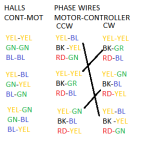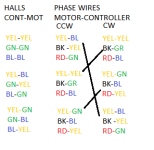DanGT86
100 kW
Hi all,
I set up a C80100 130kv motor today with an adjustable external hall board. I then tried all 36 hall/phase combos and found 6 that work. 3 CW and 3 CCW. All combos ran 5.5amps no load @ 5k rpm on 36v. That all makes sense to me and sounds reasonable as far as I know. I adjusted the hall board position until I had the lowest no load amp draw. The same timing position seemed to work in both directions as the lowest no load current.
I have read in countless places that reversing a brushless motor only requires switching any 2 phases of a running combo. This 2 phase swap is also stated in the first paragraph of the ES wiki on phase combos.
https://endless-sphere.com/w/index.php/Determining_the_Wiring_for_a_Brushless_Motor
Now for my question: How come I have NEVER been able to reverse a motor by swapping only 2 phases?
Upon examining my 6 running hall/phase combos from today's test on the 80100, there are NO reverse rotation combos where the direction change resulted from only 2 switched phases. In every single case the direction of rotation only switched when all 3 phases were switched.
So is it just me? Could it be the timing of my external hall board causing me to make the wrong determination about successful combos? Does the hall board need to be advanced specifically for each direction? Does this "swap any 2 phases" method only apply to sensorless operation? I have never found it to be true on any motor I have set up.
Thanks for any insight. I would really like to understand the theory rather than just finding a successful combo and moving on.
I set up a C80100 130kv motor today with an adjustable external hall board. I then tried all 36 hall/phase combos and found 6 that work. 3 CW and 3 CCW. All combos ran 5.5amps no load @ 5k rpm on 36v. That all makes sense to me and sounds reasonable as far as I know. I adjusted the hall board position until I had the lowest no load amp draw. The same timing position seemed to work in both directions as the lowest no load current.
I have read in countless places that reversing a brushless motor only requires switching any 2 phases of a running combo. This 2 phase swap is also stated in the first paragraph of the ES wiki on phase combos.
https://endless-sphere.com/w/index.php/Determining_the_Wiring_for_a_Brushless_Motor
Now for my question: How come I have NEVER been able to reverse a motor by swapping only 2 phases?
Upon examining my 6 running hall/phase combos from today's test on the 80100, there are NO reverse rotation combos where the direction change resulted from only 2 switched phases. In every single case the direction of rotation only switched when all 3 phases were switched.
So is it just me? Could it be the timing of my external hall board causing me to make the wrong determination about successful combos? Does the hall board need to be advanced specifically for each direction? Does this "swap any 2 phases" method only apply to sensorless operation? I have never found it to be true on any motor I have set up.
Thanks for any insight. I would really like to understand the theory rather than just finding a successful combo and moving on.



